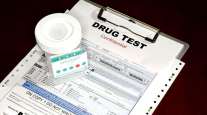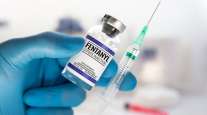Staff Reporter
FMCSA Increases Random Drug Test Rate to 50% for 2020

[Stay on top of transportation news: Get TTNews in your inbox.]
The Federal Motor Carrier Safety Administration is increasing the minimum annual percentage rate for random controlled substances testing for truck drivers.
According to a document published in the Federal Register on Dec. 27, the agency is increasing the minimum annual percentage rate for random drug testing from 25% of the average number of driver positions to 50% of the average number of driver positions. This change will take effect Jan. 1, 2020.
For reference, FMCSA estimates there are 3.2 million commercial driver license holders participating in interstate commerce and 1 million CDL holders participating in intrastate commerce. Under the annual random testing rate of 25% of all driving positions, this meant at least 1.05 million random controlled substances tests were to be conducted. With a new annual random testing rate of 50%, approximately 2.1 million random tests will need to be conducted in 2020.
2019-28164 by Transport Topics on Scribd
“This change reflects the increased positive test rate and will result in an estimated $50 million to $70 million increase in costs to the industry by requiring that more drivers be tested,” the Federal Register document states.
The minimum annual percentage rate for random alcohol testing will remain at 10%.
Tom Bray, a transportation industry consultant at J.J. Keller, said the cost increase will apply to all carriers regardless of size. J.J. Keller is a firm that specializes in safety and regulatory compliance issues.
Bray noted FMCSA’s announcement marks a return to previous random drug testing levels. FMCSA reduced the minimum annual percentage rate for 2016 from 50% to 25%. Previously, the percentage rate was 50%.
“It’s the same thing you’re doing, you just have to do more of it,” Bray told Transport Topics. “The key thing there is that it went back up to 50%, which is where it was for many, many, many years previous to the calendar year 2016 change.”
Bray said that carriers may encounter challenges meeting the 50% mark. He said random testing presents problems for fleets that experience high turnover, as drivers are frequently coming and going.
The document explains that the FMCSA administrator must increase the minimum annual random testing percentage rate when the data received under the requirements for any calendar year indicates that the reported positive rate is equal to or greater than 1%. FMCSA’s 2018 Drug and Alcohol Testing Survey revealed that the positive rate for controlled substances in random testing increased to 1%.
Each calendar year, FMCSA requires motor carriers selected for the survey to submit the results of their drug and alcohol testing programs. As part of the survey, the carriers must provide information on the number of random tests conducted and the corresponding positive rates to the agency in an accurate and timely manner.
In the 2018 survey, forms were sent to 4,480 randomly selected motor carriers. Some 1,908 of those forms were completed and returned to FMCSA. Those forms resulted in usable data from 1,552 carriers, representing 300,635 CDL-holding operators. (Nonusable data means the carriers were out of business, exempt, have no testing program or belong to consortia that did not test any drivers for the carrier during 2018.)
The 2018 survey’s estimated positive random controlled substance test rate of 1% was slightly higher than rates of previous years. The estimated positive usage rate for drugs was 0.8% in 2017 and 0.7% in 2016.
Bray said one factor that may have contributed to the test rate inching back up is the Department of Transportation’s addition of certain synthetic opioids in drug screening. Beginning Jan. 1, 2018, four synthetic opioids— hydrocodone, hydromorphone, oxymorphone and oxycodone—were included in these exams.
“That is a major issue in the country in general,” Bray said. “Our group of drivers represents the country. If the country’s having trouble with opioids, so are drivers.”
Abigail Potter, manager of safety and occupational health policy for American Trucking Associations, said the increase wasn’t unexpected in light of the addition of the synthetic opioids. However, she acknowledged some disappointment with the announcement, which provided the industry with very short notice. Potter pointed out that most companies had completed their budget planning for the upcoming year before FMCSA announced the increase, which will cost the industry millions.
Another point of frustration, Potter said, is that the increase could’ve been prevented with federal acceptance of hair testing as a way to screen for drugs. The Department of Health and Human Services’ proposed guidelines that would allow carriers to use hair testing have sat at the Office of Management and Budget since the summer.
“We need hair testing,” Potter said. “One of the disappointments here is that we could’ve prevented this situation.”
The 95% confidence interval for the 2018 estimate ranges from 0.9% to 1.1%.
“In other words, if the survey were to be replicated, it would be expected that the confidence interval derived from each replication would contain the true usage rate in 95 out of 100 surveys,” the document states.
Based on the 2018 survey results, about 94% of the subject motor carriers had random controlled substance and alcohol testing programs in place. The survey also revealed that 99% of CDL drivers participated in such programs.
FMCSA’s final rule titled “Controlled Substances and Alcohol Use and Testing,” published in 2001, set up the process by which the agency determines whether the minimum annual percentage rate for random testing should be increased or decreased. The final rule stipulated that the decision to increase or decrease the percentage rate would be based on the trucking industry’s overall positive random controlled substance test rate, as reported by motor carrier employers to FMCSA.
Want more news? Listen to today's daily briefing:




